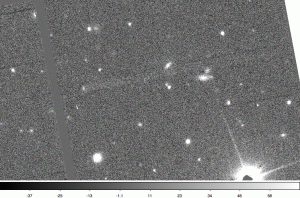Asteroid discovered by UH telescope atop Haleakala will make a close Halloween flyby
University of Hawaiʻi at MānoaEditor/Media Contact, Institute for Astronomy
Dr. Richard Wainscoat, (808) 956-8429
Astronomer, Institute for Astronomy
A large near-Earth asteroid named 2015 TB145, discovered on October 10 by the University of Hawaiʻi’s Pan-STARRS1 Telescope atop Haleakala, Maui, will pass close to Earth on October 31. The asteroid has a diameter of approximately 400 meters (1,300 feet), and will pass within approximately 480,000 km (300,000 miles) of Earth. There is no possibility of this object impacting Earth.
The asteroid is already being studied by telescopes across the planet, and soon will be targeted by radar observations that will look for details as small as 2 meters (6.5 feet) on its surface. The radar observations will directly measure its size and shape, and determine whether the object has any satellites.
When it comes closer to Earth, it will brighten to approximately 10th magnitude, which means that amateur astronomers with small telescopes should be able to see it as it moves quickly across the sky.
The asteroid has an unusual orbit that is highly inclined relative to the ecliptic plane that contains the Earth, sun, other major planets, and most asteroids. The orbit is also highly elliptical (oval), which means that after passing Earth, the asteroid will go closer to the sun than to Mercury before going back out to the outer part of its orbit, where it spends most of its time, about four times as far from the sun as Earth is. The unusual orbit of this object made it difficult to discover — the last time that it came close to Earth was approximately 30 years ago.
The search for near-Earth objects by the Pan-STARRS telescopes is funded by the NASA Near Earth Object Observations program.
Founded in 1967, the Institute for Astronomy at the University of Hawaii at Mānoa conducts research into galaxies, cosmology, stars, planets, and the sun. Its faculty and staff are also involved in astronomy education, deep space missions, and in the development and management of the observatories on Haleakala and Maunakea. The Institute operates facilities on the islands of Oʻahu, Maui, and Hawaiʻi.
For more information, visit: http://www.ifa.hawaii.edu/info/press-releases/TB145/

